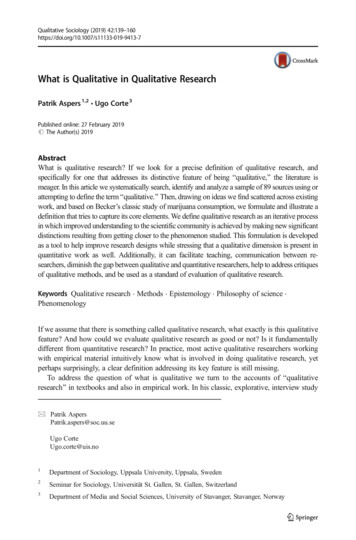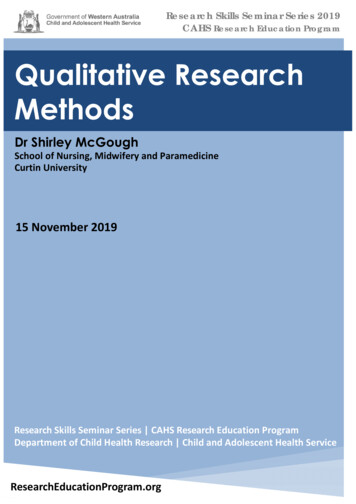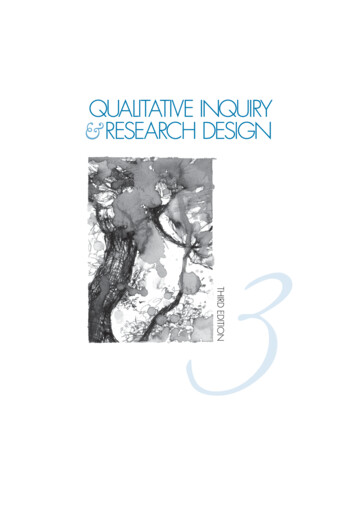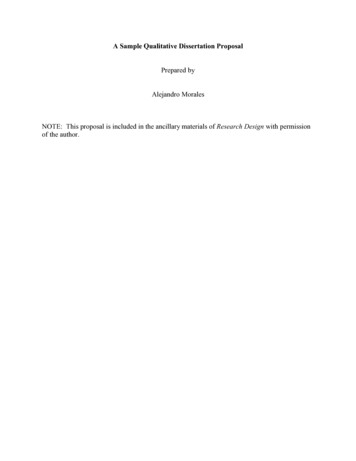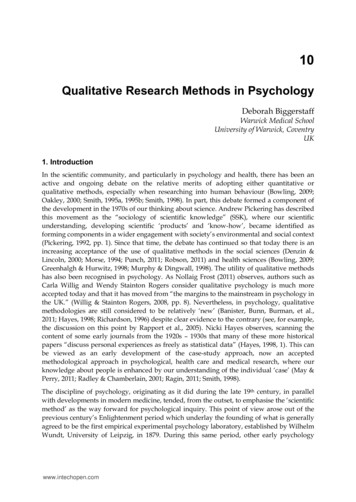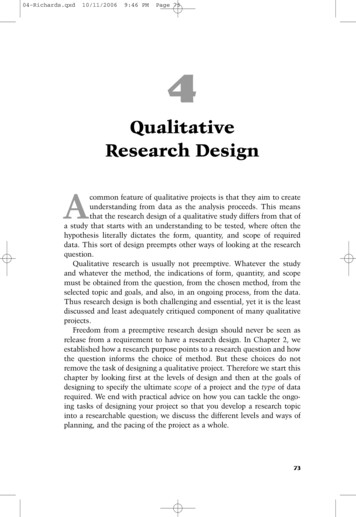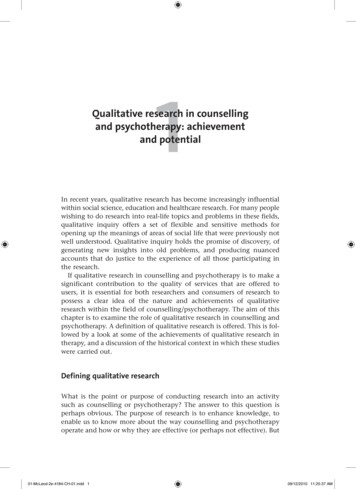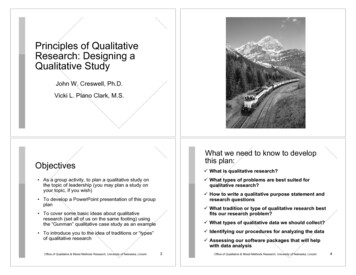
Transcription
Principles of QualitativeResearch: Designing aQualitative StudyJohn W. Creswell, Ph.D.Vicki L. Plano Clark, M.S.What we need to know to developthis plan:Objectives! What is qualitative research? As a group activity, to plan a qualitative study onthe topic of leadership (you may plan a study onyour topic, if you wish)! What types of problems are best suited forqualitative research?! How to write a qualitative purpose statement andresearch questions To develop a PowerPoint presentation of this groupplan! What tradition or type of qualitative research bestfits our research problem? To cover some basic ideas about qualitativeresearch (set all of us on the same footing) usingthe “Gunman” qualitative case study as an example! What types of qualitative data we should collect?! Identifying our procedures for analyzing the data To introduce you to the idea of traditions or “types”of qualitative researchOffice of Qualitative & Mixed Methods Research, University of Nebraska, Lincoln! Assessing our software packages that will helpwith data analysis3Office of Qualitative & Mixed Methods Research, University of Nebraska, Lincoln4
What is qualitativeresearch?What is qualitativeresearch?Qualitative research is an inquiry approach inwhich the inquirer:Qualitative research is an inquiry approachin which the inquirer: analyzes and codes the data for descriptionand themes interprets the meaning of the informationdrawing on personal reflections and pastresearch and writes the final report that includespersonal biases and a flexible structure.(adapted from Creswell 2002, p. 58) explores a central phenomenon (one keyconcept) asks participants broad, general questions collects detailed views of participants in theform of words or imagesOffice of Qualitative & Mixed Methods Research, University of Nebraska, Lincoln5Office of Qualitative & Mixed Methods Research, University of Nebraska, LincolnWhat do we need to keep in mindwhen designing a qualitativestudy?6Starting our plan Focus on process as well as outcomes Let the design emerge Let’s provide a title for our project Use inductive reasoning Develop a complex picture of the phenomenon(studying many ideas with few participants and sites) Discuss the context of the phenomenon Follow the “scientific method”(e.g., problem, questions, method, results)Office of Qualitative & Mixed Methods Research, University of Nebraska, Lincoln7Office of Qualitative & Mixed Methods Research, University of Nebraska, Lincoln8
Start with a research topic and aresearch problem Identify the subject area or topic for thestudy Let’s write down the topic and theresearch problem leading to our study Specify the research problem: The practicalissue that leads to a need for your study. Complete these sentences:– “The topic for this study will be ”– “This study needs to be conductedbecause ”Office of Qualitative & Mixed Methods Research, University of Nebraska, Lincoln9Now we will write a goodqualitative purpose statement:Office of Qualitative & Mixed Methods Research, University of Nebraska, Lincoln10Understanding the centralphenomenon: What it includes: Quantitative research– Single sentence Qualitative research– “The purpose of this study . . .”Independent– Central phenomenonVariableX– Qualitative words (e.g. “explore,”“understand,” l Phenomenon– Participants– Research siteOffice of Qualitative & Mixed Methods Research, University of Nebraska, Lincoln11Office of Qualitative & Mixed Methods Research, University of Nebraska, Lincoln12
Let’s stay away fromquantitative language thatmight mislead readersHere is a script for a goodqualitative purpose statement:“The purpose of this qualitative study (replace laterwith type of qualitative tradition) will be to(understand, describe, develop, discover)the (central focus) for(participants: person, process, groups) at(site)." What is not included in this statement:– Not a comparison– Not relating variables– Not proving hypotheses– Not measuring variablesOffice of Qualitative & Mixed Methods Research, University of Nebraska, Lincoln13Office of Qualitative & Mixed Methods Research, University of Nebraska, Lincoln14Use good qualitative wording forthese questionsWriting good qualitative researchquestions Begin with words such as “how,” “what,” Questions narrow the purpose Tell the reader what you are attempting to“discover,” “generate,” “explore,” “identify,” or“describe” Two types:– Central question Ask “what happened?” to describe The most general question you could ask Ask “What was the meaning to people of whathappened?” to understand Sub questions Ask “What happened over time?” to explore aprocess– Sub-divides central question into morespecific topics questions– Limited numberOffice of Qualitative & Mixed Methods Research, University of Nebraska, Lincoln15Office of Qualitative & Mixed Methods Research, University of Nebraska, Lincoln16
Scripts to help design qualitativecentral questions and subquestions:Avoid words such as:Central Question Script: (usually write only one)– “relate”“What does it mean to (centralphenomenon)?”– “influence”– ”impact”“How would (participants) describe(central phenomenon)?"– “effect”Sub-Question Script:– “cause”“(What) (aspect) does(participant) engage in as a (centralphenomenon)?”Office of Qualitative & Mixed Methods Research, University of Nebraska, Lincoln17Office of Qualitative & Mixed Methods Research, University of Nebraska, Lincoln18Let’s design the methods for thisqualitative study. What to include: Data collection Write the purpose statement, centralquestion, and sub-questions for ourqualitative study Data analysis Data representation Data interpretation Data validation The type of qualitative “tradition” we will use inour methodsOffice of Qualitative & Mixed Methods Research, University of Nebraska, Lincoln19Office of Qualitative & Mixed Methods Research, University of Nebraska, Lincoln20
What are the qualitativetraditions?The Qualitative TraditionsDimensionNarrative PhenomenologyEthnographyCase Study Exploring thelife of anindividual Understandingthe essence ofexperiencesabout aphenomenon Developing atheory groundedfrom data in thefield Describing andinterpreting acultural orsocial group Developing anin-depthanalysis of asingle case ormultiple casesDataCollection Primaryinterviews anddocuments Long interviewswith up to 10people Interviews with20-30individuals to“saturate”categories anddetail a theory Primarilyobservationsand interviewswith additionalartifacts duringextended time inthe field (e.g.6 months to ayear) Multiplesourcesincludingdocuments,archival records,interviews,observations, PhysicalartifactsDataAnalysis Stories Epiphanies Historicalcontent Statements Meanings Meaning themes Generaldescription of theexperience Open coding Axial Coding SelectiveCoding ConditionalMatrix Description Analysis Interpretation Description Themes AssertionsNarrativeForm Detailed pictureof an individual’slife Description of the“essence” of theexperience Theory ortheoreticalmodel Description ofthe culturalbehavior of agroup or anindividual In-depth studyof a “case” or“cases” Ethnography Grounded Theory Case StudyOffice of Qualitative & Mixed Methods Research, University of Nebraska, Lincoln21GroundedTheoryFocus Narrative researchPhenomenologyWhat criteria will we use to selecta tradition?Now, let’s select a tradition for ourstudy Intent or focus Choose a qualitative tradition for ourresearch problem. Audience Tell why we chose it and how it relates tothe study’s purpose. Personal training/skills Personal comfort level with structureOffice of Qualitative & Mixed Methods Research, University of Nebraska, Lincoln23Office of Qualitative & Mixed Methods Research, University of Nebraska, Lincoln24
Within this tradition, what data willwe collect?Four considerations for selectingpeople/sites to study: Who will be studied? Can the people and sites help us learn aboutour central phenomenon? (purposefully selectpeople and sites) What information will be collected? How many people and sites should we study?(keep sample size small) Do we have access? (gain access) Do we have permissions (obtain permissions)Office of Qualitative & Mixed Methods Research, University of Nebraska, Lincoln25Office of Qualitative & Mixed Methods Research, University of Nebraska, Lincoln26If we choose to observe, how dowe do it?What types of information can becollected in qualitative research? Create an observational protocol– Record descriptive notes Observations– Record reflective notes Interviews Decide on your observational stance Documents Enter site slowly Audio-Visual Materials Conduct multiple observations Summarize at end of each observationOffice of Qualitative & Mixed Methods Research, University of Nebraska, Lincoln27Office of Qualitative & Mixed Methods Research, University of Nebraska, Lincoln28
If we choose to interview, how dowe interview? Decide on the type of interview to use– Individual– Focus group– Telephone– e-mailLet’s write down in our plan our datacollection approach1) Sites to be studied2) People to be studied Create an interview protocol3) Permissions needed Ask open-ended questions (5-7)– allows the participant to create options forresponding– participants can voice their experiences andperspectives4) Types of data to be collected5) Forms needed for data collection If possible, tape record and transcribe for analysisOffice of Qualitative & Mixed Methods Research, University of Nebraska, Lincoln29Codes the Text forThemes to be Usedin the Research Report Exploring the databaseThe Researcher Codes the Data (i.e., locates textsegments and assigns a code to label them)Interactive Coding the data Developing findings - a description and themesSimultaneousThe Researcher Reads Through Data( i.e., obtains general sense of material) (Re) presenting the description and themesThe Researcher Prepares Data for analysis( e.g., transcribes fieldnotes) Interpreting the findings Validating the findingsThe Researcher Collects Data (i.e., a text file, such asfieldnotes, transcriptions, optically scanned material)Office of Qualitative & Mixed Methods Research, University of Nebraska, Lincoln30More specific steps in the analysisprocessOnce we collect the data, how will weanalyze it? The overall processCodes the Text forDescription to be Usedin the Research ReportOffice of Qualitative & Mixed Methods Research, University of Nebraska, Lincoln31Office of Qualitative & Mixed Methods Research, University of Nebraska, Lincoln32
How do we first explore thedatabase?Then we engage in the codingprocess that involves several steps:Divide textInitially readinto segmentsthrough dataof information Obtain a general sense of the dataLabelsegments ofinformationwith codesReduceOverlap andredundancyof codesCollapsecodes intothemes Write down memos on hard copy Think about the organization of the dataManyPagesof Text Consider whether more data are neededOffice of Qualitative & Mixed Methods Research, University of Nebraska, Lincoln33How do we divide the text intosegments? (actual coding)30-40codesCodesreducedto 20Reduce Codes to5-7 ThemesOffice of Qualitative & Mixed Methods Research, University of Nebraska, Lincoln34What are themes? Transcribe the interview Themes are broad categories of information(codes grouped together) Initially read through for general meaning Determine coding frame (sentence, paragraph, or phrase)and determine what the person is saying in the codingframe Themes can describe a setting Themes can describe what occurred Assign code labels in left margin– Use in vivo coding (their words) when possible In the 5-7 themes, have some be: a) what youwould expect; b) what you would not expect(unusual themes)– Do not over code - practice “lean coding”– Stay away from interpreting comments (10 sec rule) Look for overlap among codes Themes can also be related (chronology,grounded theory model) Combine codes into 5-7 themesOffice of Qualitative & Mixed Methods Research, University of Nebraska, LincolnManySegmentsof Text35Office of Qualitative & Mixed Methods Research, University of Nebraska, Lincoln36
Let’s practice the coding proceduresusing a sample two-page transcript onthe topic of how department chairsbalance their personal and professionallivesOffice of Qualitative & Mixed Methods Research, University of Nebraska, LincolnIn this analysis process, should we use acomputer program to help?Some computer programs //www.qsrinternational.com/http://www.maxqda.com Describe the procedures we will use foranalyzing the data37Office of Qualitative & Mixed Methods Research, University of Nebraska, Lincoln38 Demonstration of the basic features ofN6 including:– entering documents (we will enter thedepartment chair project we have coded)– coding texts– tree diagram– searching codesOffice of Qualitative & Mixed Methods Research, University of Nebraska, Lincoln40
How will we report our findings?(What topics do we present in thefindings?)As we present these findings,what visual presentations can weuse to convey them? We might describe the setting We might identify and discuss 5-7 themes (including multipleperspectives, good quotes, useful dialogue, even metaphors oranalogies) We write in detail Create a visual image of the informationin a “comparison” table We try to make the narrative as realistic as possible (even notetensions/contradictions) Depict physical layout of the setting We report the narrative in a way consistent with our tradition Describe personal or demographicinformation for each person or site– Narrative – typically a chronology– Phenomenology – typically description building toward the essenceof the phenomenon– Ethnography – description of the setting and cultural themes thatdisplay the way culture-sharing works– Grounded theory – categories of information leading to a theoreticalmodel– Case study - description of the case and themes of the caseOffice of Qualitative & Mixed Methods Research, University of Nebraska, Lincoln Present a model of a theory41At the end of our study, whatinterpretations can we make?(Discussion section of studies)42How do we know that ourinterpretation (or themes, orquestions, or the entire researchreport) is accurate? Interpretation is stepping back – asking what all ofthis means; it is not neutral Member checking: Members check the accuracy ofthe account Options:– We can give our own personal reflection (based on ourexperiences, history)– We can compare our findings with the literature– We can summarize in a general sense what we found Triangulation: Looking for themes across differenttypes of data; different researchers; differentparticipants We also need (as shown in scholarly discussionsections) Others: peer review, external audit, reportdisconfirming evidence, clarify researcher’s stance,thick description, prolonged time in the field– Raise potential limitations in our study– Make suggestions for future research– Discuss the practical implications for our studyOffice of Qualitative & Mixed Methods Research, University of Nebraska, LincolnOffice of Qualitative & Mixed Methods Research, University of Nebraska, Lincoln43Office of Qualitative & Mixed Methods Research, University of Nebraska, Lincoln44
Let’s put it all together – What topicsare addressed in a proposal for aqualitative study?A qualitative proposal (cont’d) Procedures Introduction– Characteristics of qualitative research (optional)– Statement of the problem (including literature)– Qualitative research strategy– Purpose of the study– Role of the researcher– Research questions– Data collection procedures– Delimitations and limitations– Data analysis procedures– Strategies for validating findings– Narrative structureOffice of Qualitative & Mixed Methods Research, University of Nebraska, Lincoln45Office of Qualitative & Mixed Methods Research, University of Nebraska, Lincoln46A plan for a qualitative proposal Anticipated ethical issues Significance of the study Let’s review the plan we have developedcollectively and share plans that youhave developed on your own Preliminary pilot findings Expected outcomes Appendices (interview questions,observational forms, timeline, and proposedbudget)Office of Qualitative & Mixed Methods Research, University of Nebraska, Lincoln47Office of Qualitative & Mixed Methods Research, University of Nebraska, Lincoln48
Principles of QualitativeResearch: Designing aQualitative StudyJohn W. Creswell, Ph.D.Vicki L. Plano Clark, M.S.
To cover some basic ideas about qualitative research (set all of us on the same footing) using the "Gunman" qualitative case study as an example To introduce you to the idea of traditions or "types" of qualitative research Office of Qualitative & Mixed Methods Research, University of Nebraska, Lincoln 4 What we need to know to develop

